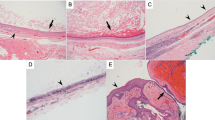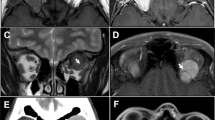Abstract
Aim
To describe the features of orbital masses occurring as a late complication of hydrogel retinal explants.
Patients and methods
Retrospective review of patients presenting with orbital masses at decades after retinal surgery.
Results
Two patients with huge orbital masses are described, their presenting 25 and 28 years after retinal detachment repair with expansile hydrogel explants. In one case, the preoperative diagnosis was pleomorphic adenoma, and the other—with extreme distortion of the globe—was considered to be lymphoma or chronic inflammation arising around prior retinal explants. At orbitotomy, the masses were found to be grossly expanded hydrogel explants that were removed piecemeal from their fibrous capsules. Histopathology showed very mild inflammation with occasional multinucleate giant cells and patchy capsular calcification, and an eosinophilic amorphous material staining strongly with Alcian-blue. Surgery was uncomplicated and both orbits healed with marked functional improvement.
Conclusion
Expansile hydrogel retinal explants were largely used in the 1980s and can present, often decades after the retinal surgery, with impaired orbital functions due to large parabulbar masses. The hydrophilic material appears to expand very slowly over decades, leading to gross distortion of neighbouring structures and a tumour-like mass.
This is a preview of subscription content, access via your institution
Access options
Subscribe to this journal
Receive 18 print issues and online access
$259.00 per year
only $14.39 per issue
Buy this article
- Purchase on Springer Link
- Instant access to full article PDF
Prices may be subject to local taxes which are calculated during checkout


Similar content being viewed by others
References
Ho PC, Chan IM, Refojo MF, Tolentino FI. The MAI hydrophilic implant for scleral buckling: a review. Ophthalmic Surg. 1984;15:511–5.
Crama N, Klevering BJ. The removal of hydrogel explants: an analysis of 467 consecutive cases. Ophthalmology. 2016;123:32–8.
Tolentino FI, Roldan M, Nassif J, Refojo MF. Hydrogel implant for scleral buckling. Long-term observations. Retina. 1985;5:38–41.
Thompson JT, Chambers WA. Good ideas gone bad: the MIRAgel saga. Ophthalmology. 2016;123:5–6.
Roh M, Lee NG, Miller JB. Complications associated with MIRAgel for treatment of retinal detachment. Semin Ophthalmol. 2018;33:89–94.
Shields CL, Demirci H, Marr BP, Mashayekhi A, Materin MA, Shields JA. Expanding MIRAgel scleral buckle simulating an orbital tumor in four cases. Ophthalmic Plast Reconstr Surg. 2005;21:32–8.
Chean CS, Lim CS, Mudhar HS, Lokovitis E, Sampath R. Chronic macular oedema as a late MIRAgel-related complication. Vision (Basel). 2021;5:55.
Tankyo Y, Harada Y, Hiyama T, Ohara H, Mizukami M, Okumichi H, et al. Irreversible intraocular pressure elevation as a complication of MIRAgel scleral buckling. Am J Ophthalmol Case Rep. 2022;27:101583.
Rubinstein TJ, Choudhary MM, Modi YS, Ehlers JP, Perry JD. Globe loss from intraocular invasion of MIRAgel scleral buckle components. Ophthalmic Plast Reconstr Surg. 2016;32:329–32.
Czyz CN, Petrie TP, Everman KR, Cahill KV, Foster JA. Hydrogel explant extrusion masquerading as a malignant eyelid lesion. Ophthalmic Plast Reconstr Surg. 2013;29:e25–7.
Figuera EC, Francis IC, Wilcsek GA. Scleral MIRAgel causing bony orbital erosion. Orbit. 2007;26:65–69.
Tong GY, Smith M, Gout T, Tumuluri K, Taylor S. Orbital and sinonasal complications of hydrogel scleral buckle: a case report. Ophthalmic Plast Reconstr Surg. 2022;38:e162–5.
Acknowledgements
The authors gratefully acknowledge the photomicrography provided by Professor Philip Luthert from the Department of Histopathology, Institute of Ophthalmology, London.
Author information
Authors and Affiliations
Contributions
GER initiated the work; all authors contributed to patient care, data acquisition and manuscript preparation.
Corresponding author
Ethics declarations
Competing interests
The authors declare no competing interests.
Additional information
Publisher’s note Springer Nature remains neutral with regard to jurisdictional claims in published maps and institutional affiliations.
Rights and permissions
Springer Nature or its licensor (e.g. a society or other partner) holds exclusive rights to this article under a publishing agreement with the author(s) or other rightsholder(s); author self-archiving of the accepted manuscript version of this article is solely governed by the terms of such publishing agreement and applicable law.
About this article
Cite this article
Mas-Castells, M., Verity, D.H. & Rose, G.E. Large orbital masses due to longstanding hydrogel retinal explants. Eye 38, 806–808 (2024). https://doi.org/10.1038/s41433-023-02783-7
Received:
Revised:
Accepted:
Published:
Issue Date:
DOI: https://doi.org/10.1038/s41433-023-02783-7



